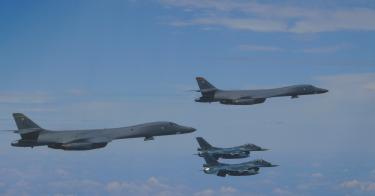North Korean leader Kim Jong Un appeared to step back just a bit from his threatened ballistic missile launch against Guam yesterday, even as U.S. officials signaled a willingness to open up a dialogue with Pyongyang.
Still Kim has said he could approve the launch of the Hwasong-12 intermediate range ballistic missiles in the direction of the island (some 4,000 miles west of Hawaii), if the “Yankees persist in their extremely dangerous reckless actions on the Korean Peninsula and its vicinity.”
Clearly U.S. policymakers are thinking about the range of possibilities.
• First, can North Korean missiles reach Guam? The short answer: Very likely —and in as little as 14 minutes after launch, according to a Guam official.
But there are doubts about warhead reliability (if one is attached) and the missile’s accuracy and reliability. For instance, could the Hwasong-12 hit Guam, a relatively small target (at only 200 square miles) 2,000 miles away?
Despite those questions, we must assume the worst — that it could.
• Second, would Pyongyang launch at Guam? That’s not at all clear now.
But why Guam?
Though there are U.S. forces in Japan and South Korea that are within North Korean missile range already, Guam is the closest U.S. territory that Pyongyang feels it can hit with confidence.
Of course, it’d be a risky roll of the security dice for Pyongyang to shoot anything toward Guam. Even a pre-announced missile test launch — though unarmed — to the waters near Guam is certainly threatening.
Again, Washington would have to presume the worst.
• Third, what can we do about it? If the United States wants to take out a North Korean missile, it has the capability to do so, including striking it while it’s still on the ground.
In that scenario, the challenge is having good intelligence on North Korean intentions. A U.S. strike on North Korean soil could be the opening salvo of a second Korean War.
Other options involve American missile defense. Depending on location, U.S. Navy Aegis ships could intercept ICBMs with surface-to-air missiles during the attacking missile’s mid-course flight phase.
Systems like land-based THAAD (Terminal High Altitude Air Defense) could also engage North Korean missiles hurtling toward Guam in their final phase of flight. Patriot missile batteries, if deployed to Guam, could back THAAD up.
Guam isn’t defenseless.
• Fourth, what should we do? Of course, we’d hope that cooler heads prevail in Pyongyang and that diplomatic pressure (for example, from China) can prevent North Korea from risking open conflict arising from a hostile missile launch.
But should North Korea send ballistic missiles in Guam’s direction — even if these missiles are meant to “bracket” the island by splashing in the ocean in a display of capability — we must act.
That means destroying any threatening North Korean missiles.
Doing this would be a purely defensive act, of course, but with the added benefit of dealing a major political, military and public relations blow to the regime and the potentates of propaganda in Pyongyang.
We needn’t stop there in retaliating for North Korean aggression, including economic embargoes, cyberattacks and military strikes of various intensities, but we could.
In the end, the U.S. has overwhelming strategic and conventional military power, which is something North Korea now appears to be thinking deeply about.
This piece originally appeared in The Boston Herald



